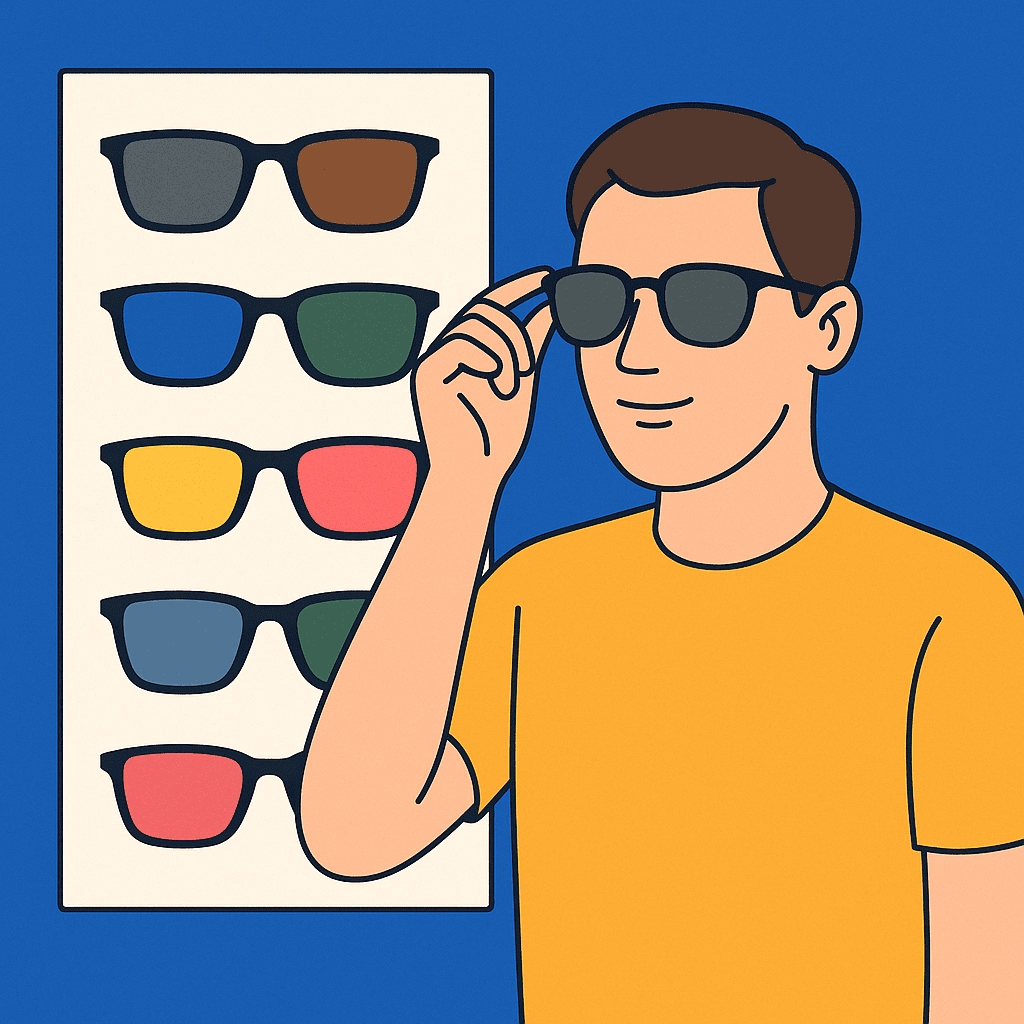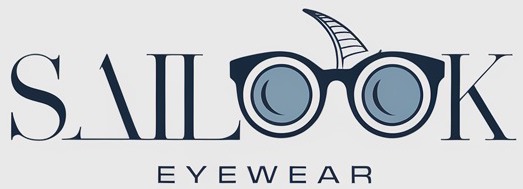Ever wonder why there are so many sunglass tint colors? Whether you’re designing for outdoor athletes, fashion consumers, or everyday drivers, choosing the right tint isn’t just about style—it affects vision, comfort, and safety. This article breaks down everything your eyewear business needs to know about lens tints, so you can help your clients make smarter choices and reduce product returns. Let’s get straight into it—this guide will make you the expert.

1. What does tint color actually do for sunglasses?
Here’s the deal—tint color isn’t just cosmetic. It plays a direct role in how light interacts with your customer’s eyes. Tints filter different wavelengths of light, changing contrast levels, reducing glare, and even altering how colors appear.
Start with gray tints. These are the most neutral—they cut brightness without changing the way the world looks. Brown lenses, on the other hand, increase contrast and depth perception, which makes them perfect for variable weather. Then there’s green—balanced brightness reduction, true color perception, and less strain in sunny conditions.
It’s also worth noting that tints can impact how clearly a person sees shapes or motion. Athletes often opt for amber or rose-colored lenses, which sharpen contrast and details. For safety and performance, this makes all the difference.
But wait—there’s more. Tints also interact with coatings, like anti-reflective layers or polarization, amplifying or muting their effect. For B2B buyers, this means not all tints behave the same even if they look identical. The material, coating, and color all play together.
Lens Tint Effects Table
| Tint Color | Visual Effect | Use Case |
|---|---|---|
| Gray | Reduces brightness evenly | General outdoor use |
| Brown | Boosts contrast | Driving, sports |
| Green | Enhances clarity | Casual & long wear |
2. Why do different activities require different tints?
This is where it gets interesting—no single tint works for everything. That’s why athletes, drivers, and office-goers all prefer different colors.
Let’s say your client is producing frames for cyclists. They’ll want lenses that increase contrast and highlight terrain variations. Amber or rose tints work best here. Skiers? They face blinding white light—brown or yellow lenses cut through glare and define contours. Meanwhile, for water sports, gray lenses with polarization eliminate surface reflection and help users see below the waterline.
Then there’s fashion use. If the end customer prioritizes appearance, blue or red-tinted lenses make a bold statement. However, they may sacrifice clarity or eye comfort over extended wear.
Ready for the good part? B2B buyers often overlook this: not matching the tint to the activity leads to higher return rates and lower customer satisfaction. Offering pre-matched tint suggestions based on use-case adds real value to your product line.
Tint Suggestions by Activity
| Activity | Recommended Tint |
|---|---|
| Cycling | Amber/Rose |
| Skiing | Brown/Yellow |
| Fishing/Boating | Gray/Green |
| City Commuting | Gray/Green |
3. How does tint color affect UV protection?
You might be wondering—do darker lenses block more UV? Actually, no. The level of UV protection depends on the lens coating, not the tint color or shade intensity.
Even clear lenses can offer 100% UVA and UVB protection if they have a proper UV400 coating. Many clients assume dark lenses automatically protect the eyes, but that’s not true. In fact, dark lenses without UV coating can be more dangerous—pupils dilate behind dark tints, allowing more harmful rays to enter.
Your job as a manufacturer or supplier is to educate clients about this. Ensure all tinted lenses are paired with verified UV protection, and display certifications like CE, FDA, or ANSI to back it up.
What’s the real story here? You can offer light-colored or fashionable tints as long as you guarantee the right coatings. This creates more product flexibility without compromising on safety.
UV Protection and Tint Comparison
| Tint Darkness | UV Protection Level | Coating Required |
|---|---|---|
| Light Yellow | 100% (with coating) | Yes |
| Dark Gray | 0–100% | Depends on lens |
| Clear | 100% (with coating) | Yes |
4. What are the most common sunglass tint colors?
Let’s break it down—there’s a reason gray, brown, and green dominate the market. These colors offer the best balance of visual clarity, glare reduction, and color accuracy.
Gray lenses reduce overall brightness without changing colors. They’re a solid all-rounder. Brown enhances contrast, especially in hazy or low-light conditions. Green lenses improve sharpness while reducing eye fatigue, making them ideal for all-day wear.
Then you’ve got specialty tints—yellow for low light, rose for snow or high-altitude sports, blue or red for statement styles. Each of these has a niche audience and application.
Here’s the kicker—knowing your customer base lets you recommend the right core tints and avoid overproducing less popular ones. Track purchase history and regional sunlight patterns to adjust your tint offerings accordingly.
Common Tint Overview
| Color | Performance | Best Use |
|---|---|---|
| Gray | Neutral view | Daily outdoor wear |
| Brown | Contrast boost | Driving, hiking |
| Green | Clarity & comfort | Long-term wear |
| Yellow | Brightening | Cloudy days, dusk |
5. Which tint is best for general everyday use?
Let’s face it—not everyone is running marathons or sailing yachts. For most people, sunglasses are for commuting, walking, or hanging out at cafes. The key here is all-day wearability and color accuracy.
Gray lenses are the safest bet. They offer balanced brightness control and keep colors looking natural. Brown is a close second, especially in areas with variable cloud cover. Green lenses work well for people with sensitive eyes or those in high-glare environments.
But here’s the twist—lifestyle plays a role. For customers who move from indoors to outdoors frequently, lighter tints or photochromic lenses might be better. If your buyer serves a mixed-use market, offering a customizable tint catalog is a smart move.
Everyday Tint Summary
| Tint | Pros | Everyday Drawbacks |
|---|---|---|
| Gray | True color, no glare | May feel flat in snow |
| Brown | Warm contrast | May slightly distort color |
| Green | Balanced clarity | Limited in dim light |
6. Which tint is ideal for driving?
Driving lenses need to do two things—cut glare and preserve true colors. Brown and gray dominate this space. Brown enhances contrast and helps define road edges or signage in low light. Gray reduces brightness on sunny highways.
Here’s a common mistake—clients choose mirrored or dark lenses thinking they’re ideal for driving. If these lack polarization or are too dark, they reduce visibility during dusk or under overpasses.
What’s the real story? Pairing brown or gray tints with polarization is the most effective combo. This ensures sharp, glare-free vision while protecting against harmful rays.
Driving Tint Chart
| Tint | Benefits on the Road | Cautions |
|---|---|---|
| Brown | Better depth, contrast | Slight color shift |
| Gray | Natural perception | Less contrast |
| Yellow | Night/overcast aid | Not for bright sun |
7. What tint should I choose for sports or performance use?
This is where performance eyewear gets technical. Athletes need vision that adapts fast, tracks motion accurately, and reduces fatigue.
Amber and rose lenses heighten depth perception and terrain contrast. Ideal for runners, mountain bikers, and tennis players. Skiers and snowboarders benefit from yellow or orange tints, which brighten their field in fog or snowy glare. Golfers often prefer green tints—it calms the eyes and tracks ball movement better on sunny days.
But wait—there’s more. Every sport has its lighting quirks. Indoor courts? Go light amber. Open roads? Go gray with a mirrored finish.
Performance Tint Matrix
| Sport | Preferred Tint | Reason |
|---|---|---|
| Running | Amber/Rose | Road visibility, contrast |
| Skiing | Yellow/Brown | Glare management in snow |
| Golf | Green/Gray | Ball clarity on grass |
8. How do tinted lenses affect color perception?
This is a big one—tint choice directly changes how wearers see colors. Gray lenses maintain natural hues. Brown and amber lenses shift colors slightly warmer, which can make greens more vibrant but blues less distinct. Rose-tinted lenses boost contrast dramatically but significantly alter color accuracy.
In practical terms, a photographer or visual artist might need gray for precision, while a mountain biker benefits from contrast-boosting brown to see obstacles. Industrial or safety eyewear should also avoid extreme tints that cause misjudgment of hazards or signals.
So, what’s the takeaway? Always advise your B2B clients to match tint characteristics with user needs. This reduces returns and ensures end users have the best possible experience with your product.
Tint and Color Accuracy Comparison
| Tint Color | Color Accuracy | Ideal For |
|---|---|---|
| Gray | High | Photography, driving |
| Brown | Medium | Hiking, daily wear |
| Rose | Low | Snow sports, cycling |
9. What about low-light or cloudy-day conditions?
Not all sunglasses are for bright summer days. Your customers will also need options that work in overcast, dusk, or foggy conditions.
This is where yellow, amber, and rose lenses shine. These tints amplify light and increase contrast, helping wearers see more clearly in flat-light scenarios. They’re perfect for early morning joggers, winter hikers, and workers in shaded areas.
But gray or dark brown lenses? They’ll be too dim. For customers using sunglasses in multiple lighting scenarios, transitional or interchangeable lens systems may be the answer.
Here’s the real advantage—offering low-light options expands your catalog to serve more time zones, climates, and use-cases.
Cloudy-Day Lens Guide
| Tint | Lighting Suitability | Typical Applications |
|---|---|---|
| Yellow | Low light | Driving in fog, indoor courts |
| Amber | Variable | Hiking, construction sites |
| Rose | Diffused light | Snow sports, cycling |
10. How should I choose a tint based on my eye sensitivity?
Not all eyes handle sunlight the same. Some people squint even under cloud cover, while others barely notice midday sun.
For light-sensitive users, green and brown lenses reduce strain. Amber and rose can soothe tired eyes over long periods. On the other hand, blue or mirrored lenses may be visually intense for some people, especially indoors.
It’s also worth considering health conditions—individuals with migraines or photophobia often find gray or amber tints the most comforting.
So, what’s the move? Provide a lens testing kit or color sample deck if you’re a B2B supplier. Let your customers see the difference before committing.
Tints for Light Sensitivity
| Sensitivity Level | Recommended Tint | Avoid This Tint |
|---|---|---|
| High | Amber/Gray | Blue/Mirror |
| Moderate | Green/Brown | Rose |
| Low | Any | N/A |
11. Are certain tints better for digital screen use?
Here’s a surprising twist—tints can affect how screens appear. While sunglasses aren’t designed for computer use, many people wear them around digital signage or while using phones outdoors.
Amber and light brown tints block some blue light, reducing eye strain. Rose lenses enhance contrast on LED displays, but may distort colors. Gray lenses offer clarity without much interference.
Now comes the catch—dark tints can make it hard to read screens in sunlight. Instead, lighter tints or even gradient lenses are a better match for mixed indoor-outdoor environments.
Digital Tint Usage Table
| Tint | Screen Visibility | Recommended Use |
|---|---|---|
| Amber | High | Outdoor screen use |
| Gray | Medium | Mixed environments |
| Dark Mirror | Low | Avoid for displays |
12. Does fashion play a role in choosing sunglass tint?
Let’s not pretend it doesn’t—style sells. Fashion-focused customers often select sunglasses based on color appeal rather than optical function.
Blue, pink, red, or gradient tints are in demand with Gen Z and trend-conscious buyers. These may not offer the best clarity, but they definitely attract attention. For B2B sellers, offering fashion-forward options as a separate product line can bring in an entirely new demographic.
But remember—design isn’t everything. Tints still need to meet safety standards and carry UV protection, even for fashion use. Style can’t come at the expense of function.
Fashion Tint Trends
| Color | Trend Level | Performance Impact |
|---|---|---|
| Pink | High | Low contrast clarity |
| Blue | Moderate | Poor glare reduction |
| Gradient | High | Good for indoor/outdoor |
13. Do mirrored lenses offer better tint protection?
You’ve seen them—flashy mirrored sunglasses that turn heads. But are they better, or just flash?
Mirrored lenses add a reflective coating that reduces the amount of light entering the eyes. This helps in extreme brightness—think snowfields, water, or deserts. When combined with a proper tint like gray or brown, mirrors reduce glare and visual fatigue.
But here’s the catch—mirror coatings scratch easily. They also add cost and may reflect surroundings so intensely they cause distractions.
Bottom line? Mirror tints are ideal for niche environments. Offer them as a premium option, not a default.
Mirror Coating Performance
| Feature | Advantage | Disadvantage |
|---|---|---|
| Light Reduction | High | Can darken vision too much |
| Glare Cut | Strong | Needs combo with good tint |
| Appearance | Bold | May be too flashy |
14. How do I test and compare sunglass tints in-store?
Here’s where you help your clients help their customers. Most people don’t know how to evaluate tints beyond “does it look good?”
Provide demo units or lens sample cards. Place them against natural light, contrast charts, and even digital screens. Allow clients to walk outdoors briefly for real-world exposure.
You can also print lens comparison guides for B2B clients—highlighting how each tint works in specific weather or lighting scenarios.
Remember this—an educated buyer is a loyal buyer. Help your clients feel confident about their selection process, and they’ll return to your brand again.
Tint Testing Checklist
| Test Tool | Purpose |
|---|---|
| Contrast Chart | Check clarity differences |
| Digital Display | Test screen readability |
| Outdoor Walk Test | Simulate real usage |
15. What are the best tint choices for prescription sunglasses?
Prescription sunglasses add complexity. Not every tint is available for every lens material or prescription type.
The most common tints for Rx lenses are gray, brown, and green. These work with single vision, bifocals, and progressive lenses. Lighter tints and photochromic options are available for users who wear glasses all day and don’t want to switch pairs.
However, mirrored or fashion colors may not be offered by all Rx labs due to coating limitations.
So what should you offer? Keep a streamlined selection for prescription customers, focusing on proven tints that balance performance, style, and Rx compatibility.
Prescription Tint Compatibility
| Tint | Rx Friendly | Notes |
|---|---|---|
| Gray | Yes | Universal choice |
| Brown | Yes | Contrast enhancer |
| Blue | Sometimes | Limited lab support |
Conclusion
So, what’s the verdict? Tint color isn’t just a fashion statement—it’s a functional feature that affects comfort, clarity, and performance. From sports to driving, from digital screens to medical conditions, each color has a purpose. Choosing the right tint can reduce returns, improve user satisfaction, and differentiate your eyewear products. Use this guide to empower your B2B customers with the knowledge they need to select the perfect lenses for their market. Because the right tint isn’t just seen—it’s felt.
FAQ
- Q1: What is a sunglass tint?
A sunglass tint is the color applied to lenses that affects how light is filtered, impacting vision clarity and comfort. - Q2: How does tint color impact vision?
Each tint alters light differently. Some enhance contrast, others reduce glare. The choice affects how you perceive shapes, colors, and brightness. - Q3: Can darker tints block more UV?
Not necessarily. UV protection comes from coatings, not the darkness of the lens. Always look for UV400 certification. - Q4: What’s the difference between gray and brown lenses?
Gray keeps colors accurate and reduces glare evenly. Brown improves contrast, especially in low-light or foggy conditions. - Q5: Is it okay to wear tinted sunglasses indoors?
Only if the tint is light and for blue light or medical use. Dark lenses indoors can cause visual strain and aren’t recommended.

